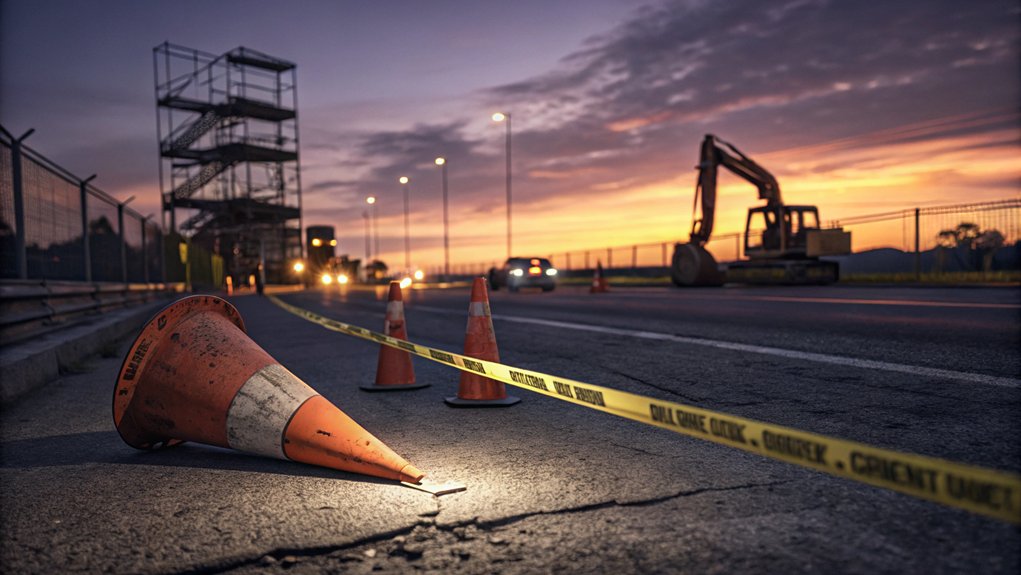Cheshire residents face soaring housing costs and vanishing services after government overhaul. Is your family's welfare at risk? Local communities struggle as policy changes reshape the county's future.
Work zone fatalities have increased 50% since 2013, with 954 deaths recorded in 2021 alone, highlighting an urgent safety crisis on America's roads. You'll find that speeding, improper lane changes, and expanding vehicle sizes contribute considerably to these incidents, which cost the economy over $38 billion annually. While positive protection barriers and strict speed enforcement help reduce risks, the rising death toll indicates a critical need for extensive infrastructure improvements. The full scope of solutions extends beyond these initial measures.
While construction zones are essential for maintaining our nation's infrastructure, they've become increasingly dangerous places for both workers and motorists, with fatalities rising 50% between 2013 and 2022. The situation reached a pivotal point in 2021, when work zone deaths climbed to 954, representing an 11% increase from the previous year's 863 fatalities.
Though 2022 showed a slight 7% decrease, the overall trend remains concerning, with one fatality occurring for every 4 billion vehicle-miles travelled. The economic impact of these crashes is staggering, costing society over $38 billion annually when you factor in medical expenses, lost productivity, and other related costs.
In 2021 alone, approximately 42,000 people suffered injuries in work zone crashes, creating considerable strain on local communities and healthcare systems. The human toll extends beyond statistics, as families and coworkers face profound psychological impacts following these tragic incidents. Studies reveal that highway contractors report work zone crashes at an alarming rate of 64%.
You'll find that bad driving behaviour, particularly speeding and improper lane changes, contributes greatly to these crashes. The growing size of vehicles on our roads, combined with narrowed lanes and changing traffic patterns in work zones, creates additional hazards for both workers and motorists.
Construction workers face particularly high risks while working on foot along roadways, with run-overs and back-overs remaining leading causes of worker fatalities. There's strong evidence that implementing positive protection barriers can greatly reduce fatalities and save billions in costs.
These safety measures, combined with strict speed limit enforcement and proper work zone planning, play essential roles in protecting lives. Advanced safety technologies and visual alert systems, such as electronic message boards and clearly marked barriers, have similarly proven effective in preventing accidents.
The construction industry continues to rank among the most dangerous sectors, with certain groups facing disproportionate risks. Hispanic workers, for instance, experience higher fatality rates in construction zones. These disparities underscore the need for thorough safety measures that protect all workers fairly.
You can't overstate the urgency of addressing this crisis through infrastructure improvements and improved safety protocols. The current fatality rates equate to losing the equivalent of multiple commercial airliners worth of lives annually, making it clear that immediate action is needed.
Most-Asked Questions FAQ
What Are the Psychological Impacts on Workers Who Witness Work Zone Accidents?
You'll likely experience PTSD, anxiety, and depression after witnessing work zone accidents. You can face severe psychological trauma, including intense fear and guilt, which is why you'll need immediate professional support.
How Do Weather Conditions Specifically Affect Work Zone Accident Rates?
You'll find that adverse weather like rain and fog drastically reduces visibility in work zones, while clear conditions can increase speeds. Both extremes affect accident rates, with poor weather typically causing more frequent but less severe crashes.
What Compensation Do Families Receive When Workers Die in Work Zones?
You'll receive workers' compensation death benefits covering funeral costs and lost wages. You can likewise pursue wrongful death claims against third parties for additional compensation, including loss of support and services provided by your loved one.
How Do Work Zone Fatality Rates Differ Between Urban and Rural Areas?
You'll find that rural work zones have particularly higher fatality rates (1.74 per 100 million VMT) compared to urban areas (1.19 per 100 million VMT), largely because of higher speed limits and limited infrastructure.
Which Construction Companies Have the Best Safety Records in Work Zones?
You'll find Andron Construction and Coffman Excavation leading the pack with exceptional safety records. They've achieved near-zero accidents through thorough OSHA training, rigorous safety orientations, and advanced incident reporting systems.
